Data-based Discussion on Education and Children in Japan
- 1. Bukatsudou--A Puzzling Activity that Most Students Join (This paper)
- 2. Analyzing Juku--Another School After School
- 3. Low Self-Esteem Among Japanese Children--How to Overcome This Issue
- 4. Issues Regarding Japanese Children's Reading--In Association with the Effects of Reading
- 5. Now's the time amid COVID-19 fear, let's close up on the positive side of a "well-regulated lifestyle"
- 6. To prevent the "cycle of poverty" -current situation in Japan concerning continuation of education to college
In this series, we examine the current landscape and issues of education in Japan based on results of surveys mainly targeting students, parents and teachers. There has been an emphasis on evidence-based educational practice and policy evaluation in Japan since the mid-2000s, and large volumes of data have been accumulated. Dissemination of such insight on a global scale, however, is still far from sufficient. As such, I intend to introduce data that depicts the current landscape of education in Japan (e.g., its strengths and challenges) to overseas researchers and practitioners. I hope you will enjoy the upcoming series.
As a starter for the forthcoming series, we discuss bukatsudou--an extracurricular activity offered in Japanese lower and upper secondary schools*. While Japanese take bukatsudou for granted, foreigners may find it quite puzzling. Below, we elaborate on the current situation and issues surrounding bukatsudou.
*For a detailed view of the Japanese school system, see https://www.childresearch.net/projects/ecec/japan.html.
Japanese Teachers are the Busiest in the World
First, let us examine the work environment of teachers in Japan. The excessive workload of teachers is currently a social issue in Japan. According to the OECD Teaching and Learning International Survey (TALIS) targeting lower secondary school teachers, teachers in Japan work the longest hours among the 34 countries and economies that participated in the survey. The average weekly working hours for all 34 countries and economies are 38.3 hours, which, on a five-day-week basis, can be converted to nearly 8 hours a day. Meanwhile, teachers in Japan work 53.9 hours a week, or nearly 11 hours a day on average, suggesting that quite a few teachers work even longer. Lights in faculty rooms of Japanese schools are often blazing till 9PM or 10PM. Teachers also commonly work at school on weekends. In fact, according to a research conducted by Benesse Educational Research and Development Institute, 70% of lower secondary school teachers who responded to the survey go to school on weekends "almost every week."
Why are teachers in Japan so busy? There are mainly two factors, as shown in the table below.
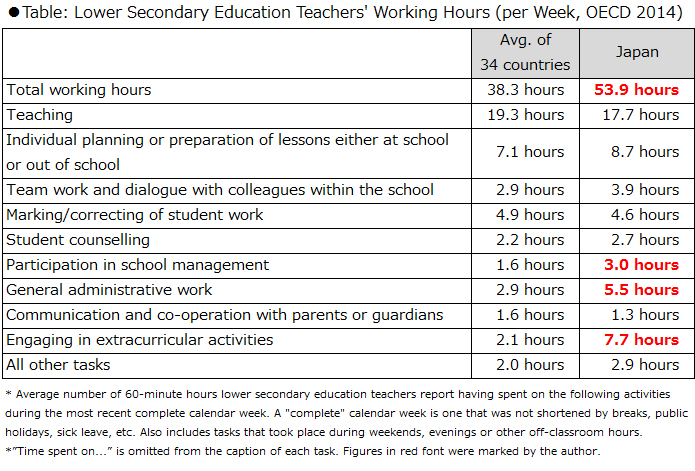
The table shows teachers' working hours based on TALIS and indicates that teachers in Japan spend a lot of time on "participation in school management" and "general administrative work." Since schools in Japan do not explicitly differentiate occupation by line of work, teachers not only teach classes, but also engage extensively in school management. The large volume of such administrative work is one of the factors making teachers busy.
Another factor is the lengthy time spent on "engaging in extracurricular activities," consuming an average of 7.7 hours per week, which is 3.7 times the average of all 34 countries and economies. Time spent on extracurricular activities is longest following "teaching" and "individual planning or preparation of lessons either at school or out of school," accounting for 14.3% of one's total working hours. Most teachers in Japan instruct extracurricular activities after classes, including sports, art and music. While such bukatsudou instruction is not so common internationally, it is common practice in Japan. In short, teachers in Japan are busy due to the massive workload aside from teaching classes.
Extent of Students' Participation in Bukatsudou
How actively do Japanese students take part in bukatsudou? Chart 1 shows the participation rate. Combining sport teams and cultural clubs, the rate is 80% for lower secondary school students and 70% for upper secondary school students. Sport teams include soccer, baseball, basketball, volleyball, tennis, table tennis, rugby, track and field, and swimming. Many schools also have traditional Japanese sport teams such as judo, kendo (fencing) or kyudo (archery). Cultural clubs also range widely, represented by brass band, chorus, art and drama, and in some schools, traditional Japanese culture such as sado (tea ceremony), kado (flower arrangement) or shodo (calligraphy). For each activity, there are usually regional and/or national tournaments and competitions in which students strive to achieve better results.
As shown in the chart, male students tend to join sport teams, while female students tend to join cultural clubs. The participation rate of 3rd graders in both lower and upper secondary school is low because many quit bukatsudou prior to upper secondary school or university entrance exams. Overall, many, if not most students join bukatsudou after classes.
How often do these activities take place? Although we omit the chart, the majority of bukatsudou takes place 6-7 days a week, and on average, 2-3 hours a day. It consumes some 14 hours a week and generally takes place almost every day including weekends. Bukatsudou is completely voluntary, so students are free to decide whether or not to join. Moreover, the Japanese law prescribes that public school teachers shall not be ordered to work outside of regular working hours, implying that teachers are not obligated to instruct bukatsudou. In other words, many schools are spending large amounts of time strenuously engaging in "non-compulsory" activities.
Skills Nurtured through Bukatsudou
There are many advantages in offering bukatsudou at school. One is that it provides equal opportunities to students. It is in itself fascinating that such wide-ranging experiences are offered uniformly to students nationwide.
Since bukatsudou is provided from lower secondary school in most regions, many households use paid after-school activity services provided by private organizations while their children are in elementary school. According to a joint research by Benesse Educational Research and Development Institute and the University of Tokyo, some 80% of elementary school students participate in private after-school activities represented by sports, art or music. However, since such activities require a fee, the extent of participation is affected by economic factors of each household. Furthermore, there are disparities among regions for certain types of activities, with urban areas usually being advantageous. Contrarily, bukatsudou is offered in every lower and upper secondary school in Japan, and at a reasonable cost, which enables all students, regardless of socio-economic background, to gain an opportunity to participate.
Bukatsudou offers other benefits as well; namely, it nurtures social and emotional skills. Bukatsudou enables students to concentrate on an activity of their preference during their secondary education years when their personal development is most rapid. Needless to say, skills that are fostered will differ depending on the activity, but one can imagine that regardless of the type of sport or activity a student joins, he or she will nurture many qualities and capabilities required to survive in society through endeavoring to achieve a common goal with peers. Japanese companies are said to have a tendency to prefer recruiting students who were members of sport teams because such students are commonly believed to be polite and patient, and to excel in collaborating with others to execute a task. OECD defines capabilities essential in driving personal success or social progress, such as achieving goals, collaborating with others and controlling emotions, as social and emotional skills. Bukatsudou offers a place for such qualities and capabilities to be nurtured outside the regular curriculum.
Our own research validates this advantage to a certain extent, suggesting that students participating in bukatsudou have a wider circle of friends, and that their relationships are more intimate. Chart 2 below shows the results of what students believe they are "proficient" or "not proficient" in, classified by whether they take part in bukatsudou. The value for "proficient" in multiple categories is higher for bukatsudou members. In particular, sport team members had a significantly higher ratio of responding that they are "proficient" in "acting on one's own will," "presenting one's thoughts before others," "leading a group as leader," and "cooperating to bring the group together." That said, there is not enough evidence validating what kind of capabilities are nurtured through bukatsudou; therefore, further research is needed in this area going forward.
"Excessiveness" is the Major Problem
While bukatsudou has many advantages as mentioned, the major problem it poses is its excessiveness. Bukatsudou is supposed to be an extracurricular, voluntary activity, so students who want to participate should do so within their capacity. Yet, when asked whether they enjoy bukatsudou, while 90% responded "Yes," 10% responded "No." Some students continue bukatsudou just for the sake of maintaining friendship even if they find the activity painstaking, and half of the students feel that "bukatsudou is gruelling due to its frequency" (Chart 3). Some schools obligate bukatsudou participation in light of the significant educational effects it holds, and even in schools where bukatsudou is non-compulsory, participation is often implicitly taken for granted.
Instructing bukatsudou imposes a heavy burden on teachers as well. Although instruction is not obligatory, teachers are expected to tacitly accept such roles for no additional remuneration no matter how actively they are engaged. Since somebody needs to instruct/coach the students, teachers serve this role purely based on a sense of "altruism."
Survey results show that teachers have ambivalent feelings toward bukatsudou. In a survey asking their opinion on bukatsudou, about half regarded it as an integral part of schools' educational activities, responding that they want to actively take part. Many teachers acknowledge the educational significance of bukatsudou from actually observing students mature as a person. However, at the same time, they are overwhelmed by the excessive amount of work. Working long hours and not being able to rest well on weekends should interfere with time spent on household chores or raising their own children. About 80% of the teachers are in favor of increasing the number of external instructors, and think that teachers' workloads should be reduced.
Prospects of Bukatsudou
Why is bukatsudou not scaled down despite its intensiveness and the excessive burden felt by students and teachers alike? Experts researching bukatsudou point out that activities tend to heat up precisely because they are "voluntary." Since classroom hours for respective subjects are predetermined, nobody would, for example, consider doubling classroom hours for Japanese classes. On the other hand, members and instructors tend to increase bukatsudou hours with an aim to become better or stronger, specifically because it is "voluntary." Once something is decided "for the sake of the team," it is difficult for one to object even if that decision is too demanding for individuals. To put a brake on this situation, Japan Sports Agency announced a guideline outlining such proposals as setting regular off-days or limiting bukatsudou hours ("Comprehensive Guideline for Sports Bukatsudou") in March 2018. With regards to sports, it has also been shown from the perspective of sports medicine that excessive activities can cause adverse effects (e.g., risk of injuries).
Equally imperative is the reform of teachers' work style. Despite the many advantages of offering bukatsudou at school, it is harsh to have teachers bear all the costs, relying wholly on their "altruism." Bukatsudou hours need to be reduced adequately to the extent that its advantages are not detracted, and schools need to hire external instructors, thereby involving those other than teachers. To achieve this end, we believe it is necessary to design a framework that prevents teachers' overwork through such measures as securing governmental budgets or having households bear an appropriate portion of the related costs. The Ministry of Education, Culture, Sports, Science and Technology is planning to raise budgets for hiring bukatsudou instructors. Although this raise is insufficient to serve as an instant remedy, there is no other choice but to gradually improve the current situation.
As bukatsudou instruction is not obligatory work of teachers, one feasible idea would be to shift this role to local sports teams or private service providers. However, at present, there are not enough prospective platforms capable of serving such functions. Additionally, if bukatsudou is offered outside of school, the disparity among families and regions will become an issue of concern. Furthermore, it is questionable whether values generated through bukatsudou can be replicated outside of school. We also cannot disregard the significance bukatsudou holds in terms of relationship among students and between students and teachers, and its positive impact on school education as a whole. We believe it would be ideal to revamp the bukatsudou system while maintaining the current school-based approach.



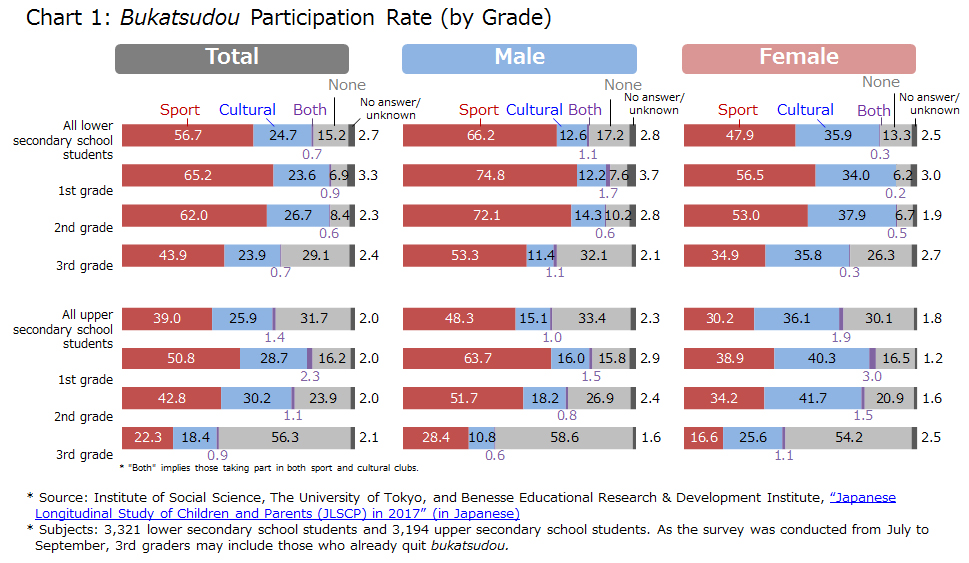
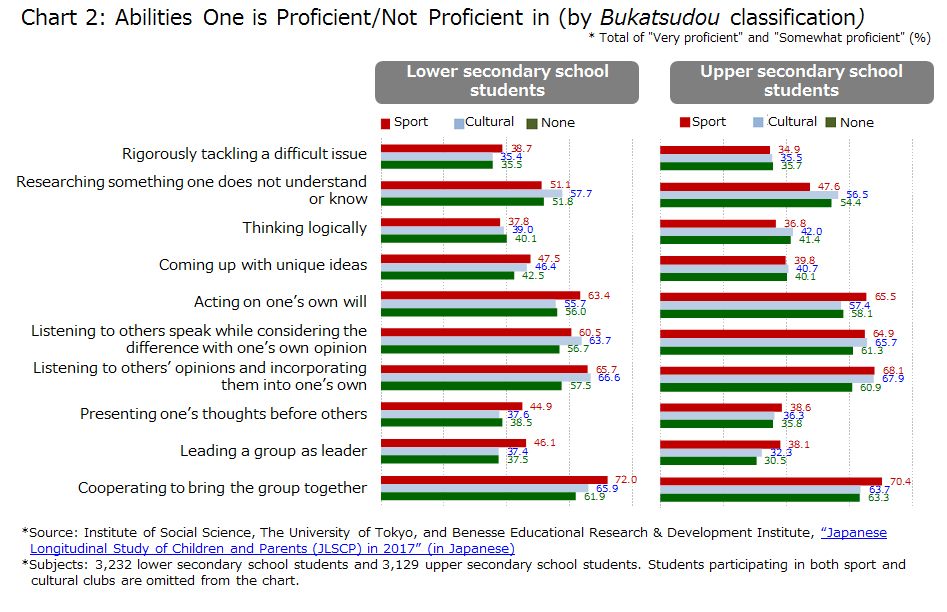
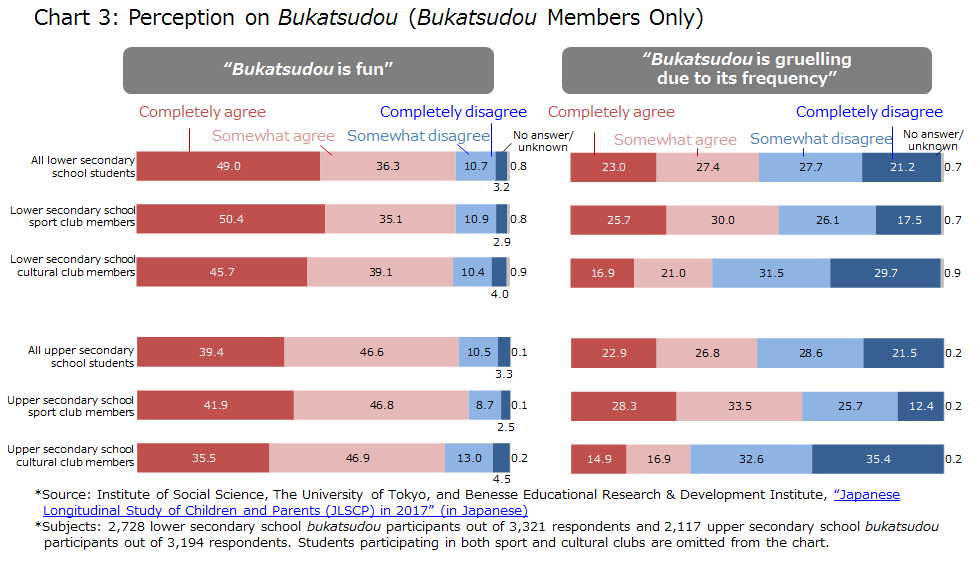
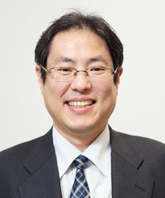 Haruo Kimura
Haruo Kimura










